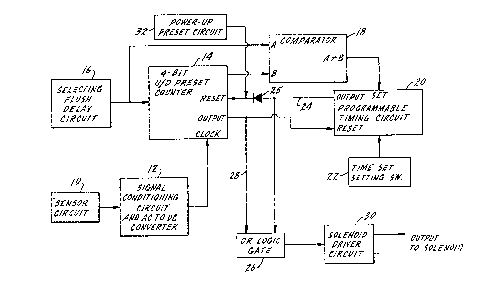Some of the information on this Web page has been provided by external sources. The Government of Canada is not responsible for the accuracy, reliability or currency of the information supplied by external sources. Users wishing to rely upon this information should consult directly with the source of the information. Content provided by external sources is not subject to official languages, privacy and accessibility requirements.
Any discrepancies in the text and image of the Claims and Abstract are due to differing posting times. Text of the Claims and Abstract are posted:
| (12) Patent: | (11) CA 2076438 |
|---|---|
| (54) English Title: | PROGRAMMABLE URINAL FLUSHING DELAY CIRCUIT |
| (54) French Title: | CIRCUIT DE DELAI PROGRAMMABLE DE CHASSE D'EAU |
| Status: | Term Expired - Post Grant Beyond Limit |
| (51) International Patent Classification (IPC): |
|
|---|---|
| (72) Inventors : |
|
| (73) Owners : |
|
| (71) Applicants : | |
| (74) Agent: | DENNISON ASSOCIATES |
| (74) Associate agent: | |
| (45) Issued: | 1998-07-28 |
| (22) Filed Date: | 1992-08-19 |
| (41) Open to Public Inspection: | 1993-03-07 |
| Examination requested: | 1994-07-14 |
| Availability of licence: | N/A |
| Dedicated to the Public: | N/A |
| (25) Language of filing: | English |
| Patent Cooperation Treaty (PCT): | No |
|---|
| (30) Application Priority Data: | ||||||
|---|---|---|---|---|---|---|
|
An apparatus for controlling flushing of a toilet
device detects use of the toilet device and compares the actual
number of uses against a preset number of uses which are
permitted before flushing of the toilet device. When the actual
number of uses equals the predetermined number of uses, the
toilet device is flushed. At the first use of the toilet device
after flushing, a timing cycle is initiated and the timing cycle
will cause flushing of the toilet device unless there is the
predetermined number of uses of the device within the period of
the timing cycle.
Dispositif permettant de réguler la chasse d'eau d'une cuvette sanitaire. Le dispositif détecte toute utilisation de la cuvette sanitaire et compare le nombre réel d'utilisations par rapport au nombre préétabli d'utilisations permises, qui détermine le déclenchement de la chasse d'eau. Lorsque le nombre réel d'utilisations correspond au nombre préétabli, la chasse d'eau est déclenchée. Dès la première utilisation de la cuvette sanitaire après une chasse d'eau, un cycle de minuterie est activé et, s'il s'écoule avant que le nombre déterminé d'utilisations ne soit atteint, il déclenche la chasse d'eau.
Note: Claims are shown in the official language in which they were submitted.
Note: Descriptions are shown in the official language in which they were submitted.

2024-08-01:As part of the Next Generation Patents (NGP) transition, the Canadian Patents Database (CPD) now contains a more detailed Event History, which replicates the Event Log of our new back-office solution.
Please note that "Inactive:" events refers to events no longer in use in our new back-office solution.
For a clearer understanding of the status of the application/patent presented on this page, the site Disclaimer , as well as the definitions for Patent , Event History , Maintenance Fee and Payment History should be consulted.
| Description | Date |
|---|---|
| Inactive: Expired (new Act pat) | 2012-08-19 |
| Inactive: Agents merged | 2008-11-26 |
| Inactive: IPC from MCD | 2006-03-11 |
| Grant by Issuance | 1998-07-28 |
| Pre-grant | 1998-03-26 |
| Inactive: Final fee received | 1998-03-26 |
| Notice of Allowance is Issued | 1997-10-03 |
| Letter Sent | 1997-10-03 |
| Notice of Allowance is Issued | 1997-10-03 |
| Inactive: Status info is complete as of Log entry date | 1997-09-30 |
| Inactive: Application prosecuted on TS as of Log entry date | 1997-09-30 |
| Inactive: IPC removed | 1997-09-10 |
| Inactive: IPC assigned | 1997-09-10 |
| Inactive: IPC removed | 1997-09-10 |
| Inactive: First IPC assigned | 1997-09-10 |
| Inactive: IPC assigned | 1997-09-10 |
| Inactive: Approved for allowance (AFA) | 1997-08-11 |
| All Requirements for Examination Determined Compliant | 1994-07-14 |
| Request for Examination Requirements Determined Compliant | 1994-07-14 |
| Application Published (Open to Public Inspection) | 1993-03-07 |
There is no abandonment history.
The last payment was received on
Note : If the full payment has not been received on or before the date indicated, a further fee may be required which may be one of the following
Please refer to the CIPO Patent Fees web page to see all current fee amounts.
Note: Records showing the ownership history in alphabetical order.
| Current Owners on Record |
|---|
| SLOAN VALVE COMPANY |
| Past Owners on Record |
|---|
| CHARLES S. ALLEN |
| NHON T. VUONG |